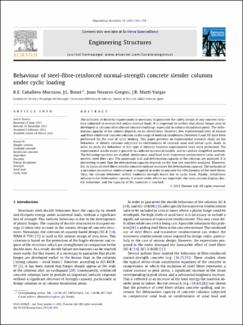Mostrar el registro sencillo del ítem
Behaviour of steel-fibre-reinforced normal-strength concrete slender columns under cyclic loading
| dc.contributor.author | Caballero Morrison, Karen E. | |
| dc.contributor.author | Bonet, José L. | |
| dc.contributor.author | Navarro Gregori, Juan | |
| dc.date.accessioned | 2017-08-17T17:24:40Z | |
| dc.date.accessioned | 2017-08-17T17:24:40Z | |
| dc.date.available | 2017-08-17T17:24:40Z | |
| dc.date.available | 2017-08-17T17:24:40Z | |
| dc.date.issued | 2012-03-28 | |
| dc.date.issued | 2012-03-28 | |
| dc.identifier.uri | http://ridda2.utp.ac.pa/handle/123456789/2823 | |
| dc.identifier.uri | http://ridda2.utp.ac.pa/handle/123456789/2823 | |
| dc.description | The inclusion of ductility requirements is necessary to guarantee a safety design of concrete structures subjected to unexpected and/or reversal loads. It is important to outline that plastic hinges may develop in columns of reinforced concrete buildings, especially in column-foundation joints. The deformation capacity of the column depends on its slenderness. However, for the case of cyclic loading, few experimental tests of normal and fibre-reinforced concrete columns in the range of medium slenderness (between 5 and 10) have been performed. This paper presents an experimental research work on the behavior of slender columns subjected to combinations of constant axial and lateral cyclic loads. In order to study the behavior of this type of elements fourteen experimental tests are performed. The experimental results make it possible to calibrate numerical models, as well as, to validate simplified methods. The following variables are studied: slenderness, axial load level, volumetric transverse reinforcement ratio, and volumetric steel-fibre ratio. The maximum load and deformation capacity of the columns has been analyzed. It is interesting to note that ductility depends on the four tested variables analyzed. Moreover, the inclusion of steel-fibres into the concrete mixture increases the deformation capacity. In order to improve the steel fibres effectiveness the inclusion of a minimum transverse reinforcement is required. Thus, the column behavior suffers moderate strength losses due to cyclic loads. Finally, slenderness influences the deformation capacity if second-order effects are important, the cross-section has a ductile behavior, and materials capacity is reached | en_US |
| dc.description.abstract | The inclusion of ductility requirements is necessary to guarantee a safety design of concrete structures subjected to unexpected and/or reversal loads. It is important to outline that plastic hinges may develop in columns of reinforced concrete buildings, especially in column-foundation joints. The deformation capacity of the column depends on its slenderness. However, for the case of cyclic loading, few experimental tests of normal and fibre-reinforced concrete columns in the range of medium slenderness (between 5 and 10) have been performed. This paper presents an experimental research work on the behavior of slender columns subjected to combinations of constant axial and lateral cyclic loads. In order to study the behavior of this type of elements fourteen experimental tests are performed. The experimental results make it possible to calibrate numerical models, as well as, to validate simplified methods. The following variables are studied: slenderness, axial load level, volumetric transverse reinforcement ratio, and volumetric steel-fibre ratio. The maximum load and deformation capacity of the columns has been analyzed. It is interesting to note that ductility depends on the four tested variables analyzed. Moreover, the inclusion of steel-fibres into the concrete mixture increases the deformation capacity. In order to improve the steel fibres effectiveness the inclusion of a minimum transverse reinforcement is required. Thus, the column behavior suffers moderate strength losses due to cyclic loads. Finally, slenderness influences the deformation capacity if second-order effects are important, the cross-section has a ductile behavior, and materials capacity is reached | en_US |
| dc.language | eng | |
| dc.language.iso | eng | en_US |
| dc.rights | https://creativecommons.org/licenses/by-nc-sa/4.0/ | |
| dc.rights | info:eu-repo/semantics/openAccess | |
| dc.subject | Slender column | en_US |
| dc.subject | confined concrete | en_US |
| dc.subject | reinforced concrete | en_US |
| dc.subject | steel fibre | en_US |
| dc.subject | ductility | en_US |
| dc.subject | energy dissipation | en_US |
| dc.subject | strength | en_US |
| dc.subject | axial load | en_US |
| dc.subject | cyclic load | en_US |
| dc.subject | Slender column | |
| dc.subject | confined concrete | |
| dc.subject | reinforced concrete | |
| dc.subject | steel fibre | |
| dc.subject | ductility | |
| dc.subject | energy dissipation | |
| dc.subject | strength | |
| dc.subject | axial load | |
| dc.subject | cyclic load | |
| dc.title | Behaviour of steel-fibre-reinforced normal-strength concrete slender columns under cyclic loading | en_US |
| dc.type | info:eu-repo/semantics/article | |
| dc.type | info:eu-repo/semantics/publishedVersion |
